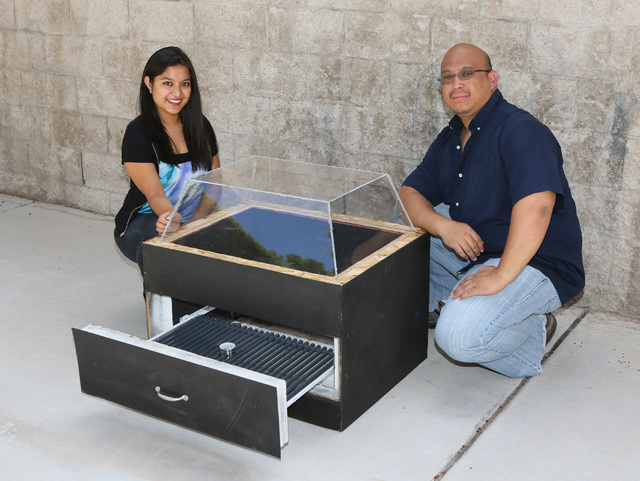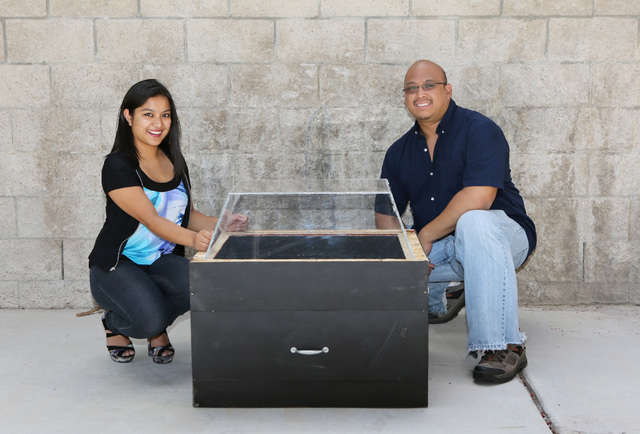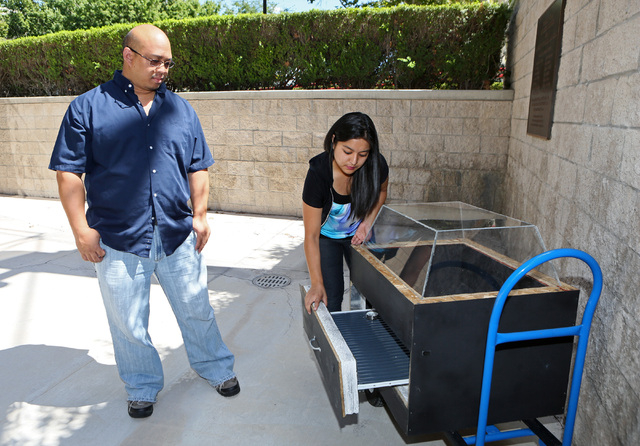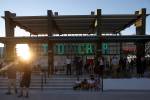Libraries battle bed bugs in books
The vampire in the teen romance your daughter checked out from the library is fictional — but there could be a bloodsucker lurking in the book’s binding that isn’t make believe.
A bed bug was spotted in a Las Vegas-Clark County Library District bin two weeks ago in the service center where 18,000 library items are sorted daily, said Karen Bramwell-Thomas, the district’s public relations manager. The stowaway was captured with tape, but some UNLV students think there might be a way to kill the creatures before they get past the book drop.
UNLV undergraduate engineering students Jack Cheney, Nicole Ramos and Vachara Maneeraj created a solar-powered book drop that roasts bed bugs to death. The project was part of UNLV’s engineering senior design competition in May. All engineering students must collaborate for a year to produce a product using their engineering skills.
Inspiration came when Shawn Gerstenberger, dean of the School of the Community Health Sciences, spoke to the students during the fall 2013 semester about the public health challenge of bed bugs sneaking into library books.
Hotels and apartments are better known hosts of bed bug battles, but the pests also are a problem for public spaces — like libraries — as the creatures are excellent hitchhikers.
Libraries have had to close because of infestations, and some places have protocol that requires destroying books that come into contact with the bugs.
Knowing heat destroys bed bugs, the students decided to see if they could craft an inexpensive solution using solar power.
The result was an insulated wooden black box with a Plexiglas top that barbecues the bugs.
The cooking comparison isn’t hype — returned books land on an actual grill, a cautionary measure for the unlikely scenario in which a bug tries to escape.
If a bed bug tries to crawl out of a book, it will fall through the grill into a powdery abrasive earth mixture, which will stick to the bug and slice up its exoskeleton, ensuring its demise, Ramos said.
TESTING THE BUG BOX
How do they know it works?
The students ordered 75 bed bugs online, through a supplier that ensured the bugs were for academic use, and tested the deadly book drop.
Maneeraj remembers when the distinctive package was delivered to his home, complete with an ice pack so the creatures wouldn’t die in route. Excited, he raced into his garage so he could peer into the parcel away from any furniture.
Then he made the phone call to his teammates, “We got them.”
The students worked on a $1,000 budget, testing prototypes before building the final design, which the students said cost about $400.
Ramos said working on a project that forced them to apply their engineering skills to a real world situation reassured them that they would actually learned something.
The students said they are interested in shopping the project around and have applied for a patent.
While designed to slay bed bugs, the book drop could also be useful in snuffing out germs, such as those that cause the common cold, Ramos said.
Bed bug expert Dawn Gouge, a public health entomologist and associate professor at the University of Arizona, called the bed bug killing book drop “fantastic.” She suggested the drop be developed to work for everything someone might check out. Materials such as DVDs also are at risk, Gouge said.
Gouge called bed bugs a “national crisis.” Even in a scenario like renting a tux, there’s a risk.
“We’ve definitely had a lot of issues with librarians going, ‘What the heck is that?’ ” Gouge said, noting that over the past few years many libraries have trained staff about the pests, which Las Vegas-Clark County Library District started doing in 2010.
The pests are a problem for libraries everywhere, Gouge said. If a library says bed bugs aren’t a concern, it’s likely they are in denial or unaware of the issue, she said.
BE VIGILANT
While the Las Vegas-Clark County Library District recently had a bed bug encounter, Bramwell-Thomas said the district has only faced intermittent bed bug issues and has never had an infestation or needed to close one of its libraries because of bed bugs.
Henderson Libraries don’t have a protocol for bed bugs because the critters have never caused an issue, said Angela Thornton, executive director of Henderson Libraries, who added the book drop sounded fascinating.
North Las Vegas Library District staff are instructed to inspect returned items, said North Las Vegas Library District director Forrest Lewis. If there is any indication of bed bugs, the book would be sealed in a plastic bag and quarantined, he said.
Lewis said North Las Vegas libraries haven’t had any incidents with bed bugs but stay cautious because the insects have been problematic for libraries throughout the country.
Bed bugs shouldn’t stop anyone from going to the library, Gouge said. The public should be vigilant, she said, but there is a only a rare chance that someone will encounter a bed bug in a library book.
If a bed bug does find its way into your book, you would likely see it, Gouge said. Typically, it’s the well-fed adult bed bugs that survive in books, and those are easily seen with the naked eye, she said. Bed bug eggs, which could end up in the spine of a book, are also visible to the naked eye, she said.
The trick is being a careful reader and knowing what the bugs look like. Watch for the dark spots the bugs leave in their wake, she said. Gouge recommended that people inspect library books and their bindings.
Luckily for Las Vegans, summer reading can be easily debugged by leaving a book in a hot car.
Ramos said the students initially tested their idea by monitoring temperatures of books left in cars. Bed bugs die at 120 degrees, she said.
Contact Bethany Barnes at bbarnes@reviewjournal.com or 702-477-3861. Find her on Twitter: @betsbarnes.

































